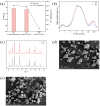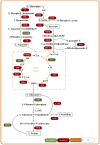Adaptive Evolution of Sporosarcina pasteurii Enhances Saline-Alkali Resistance for High-Performance Concrete Crack Repair via MICP
- PMID: 40732037
- PMCID: PMC12300605
- DOI: 10.3390/microorganisms13071526
Adaptive Evolution of Sporosarcina pasteurii Enhances Saline-Alkali Resistance for High-Performance Concrete Crack Repair via MICP
Abstract
Microbially induced calcium carbonate precipitation (MICP) has emerged as a research focus in concrete crack remediation due to its environmental compatibility and efficient mineralization capacity. The hypersaline conditions of seawater (average 35 g/L NaCl) and alkaline environments (pH 12) within concrete cracks pose significant challenges to the survival of mineralization-capable microorganisms. To enhance microbial tolerance under these extreme conditions, this study employed a laboratory adaptive evolution strategy to successfully develop a Sporosarcina pasteurii strain demonstrating tolerance to 35 g/L NaCl and pH 12. Comparative analysis of growth characteristics (OD600), pH variation, urease activity, and specific urease activity revealed that the evolved strain maintained growth kinetics under harsh conditions comparable to the parental strain under normal conditions. Subsequent evaluations demonstrated the evolved strain's superior salt-alkali tolerance through enhanced enzymatic activity, precipitation yield, particle size distribution, crystal morphology, and microstructure characterization under various saline-alkaline conditions. Whole-genome sequencing identified five non-synonymous mutated genes associated with ribosomal stability, transmembrane transport, and osmoprotectant synthesis. Transcriptomic profiling revealed 1082 deferentially expressed genes (543 upregulated, 539 downregulated), predominantly involved in ribosomal biogenesis, porphyrin metabolism, oxidative phosphorylation, tricarboxylic acid (TCA) cycle, and amino acid metabolism. In concrete remediation experiments, the evolved strain achieved superior performance with 89.3% compressive strength recovery and 48% reduction in water absorption rate. This study elucidates the molecular mechanisms underlying S. pasteurii's salt-alkali tolerance and validates its potential application in the remediation of marine engineering.
Keywords: MICP; Sporosarcina pasteurii; anti permeability; compressive strength; genome; laboratory adaptive evolution; transcriptome.
Conflict of interest statement
The author declares no conflicts of interest.
Figures










Similar articles
-
Microbially Induced Calcium Carbonate Precipitation by Sporosarcina pasteurii: a Case Study in Optimizing Biological CaCO3 Precipitation.Appl Environ Microbiol. 2023 Aug 30;89(8):e0179422. doi: 10.1128/aem.01794-22. Epub 2023 Jul 13. Appl Environ Microbiol. 2023. PMID: 37439668 Free PMC article. Review.
-
An indigenous bacterium with enhanced performance of microbially-induced Ca-carbonate biomineralization under extreme alkaline conditions for concrete and soil-improvement industries.Acta Biomater. 2021 Jan 15;120:304-317. doi: 10.1016/j.actbio.2020.11.016. Epub 2020 Nov 16. Acta Biomater. 2021. PMID: 33212232
-
Assessment of ecofriendly carbon capture using Bacillus subtilis induced calcium carbonate precipitation with focus on applications mechanisms and cost efficiency.Sci Rep. 2025 Jul 1;15(1):21906. doi: 10.1038/s41598-025-06688-1. Sci Rep. 2025. PMID: 40594560 Free PMC article.
-
Interfacial crack self-healing by Sporosarcina pasteurii: From medium optimization to spore encapsulation.Biointerphases. 2024 Nov 1;19(6):061006. doi: 10.1116/6.0004099. Biointerphases. 2024. PMID: 39688355
-
Management of urinary stones by experts in stone disease (ESD 2025).Arch Ital Urol Androl. 2025 Jun 30;97(2):14085. doi: 10.4081/aiua.2025.14085. Epub 2025 Jun 30. Arch Ital Urol Androl. 2025. PMID: 40583613 Review.
References
-
- Ragab A.M., Elgammal M.A., Hodhod O.A., Ahmed T.E. Evaluation of Field Concrete Deterioration under Real Conditions of Seawater Attack. Constr. Build. Mater. 2016;119:130–144. doi: 10.1016/j.conbuildmat.2016.05.014. - DOI
-
- Qu F., Li W., Zeng X., Luo Z., Wang K., Sheng D. Effect of Microlimestone on Properties of Self-Consolidating Concrete with Manufactured Sand and Mineral Admixture. Front. Struct. Civ. Eng. 2020;14:1545–1560. doi: 10.1007/s11709-020-0678-4. - DOI
-
- Qu F., Li W., Dong W., Tam V.W.Y., Yu T. Durability Deterioration of Concrete under Marine Environment from Material to Structure: A Critical Review. J. Build. Eng. 2021;35:102074. doi: 10.1016/j.jobe.2020.102074. - DOI
-
- Zhang M., Xu R., Liu K., Sun S. Research Progress on Durability of Marine Concrete under the Combined Action of Cl− Erosion, Carbonation, and Dry–Wet Cycles. Rev. Adv. Mater. Sci. 2022;61:622–637. doi: 10.1515/rams-2022-0049. - DOI
-
- Fan Q., Fan L., Quach W.-M., Zhang R., Duan J., Sand W. Application of Microbial Mineralization Technology for Marine Concrete Crack Repair: A Review. J. Build. Eng. 2023;69:106299. doi: 10.1016/j.jobe.2023.106299. - DOI
LinkOut - more resources
Full Text Sources

